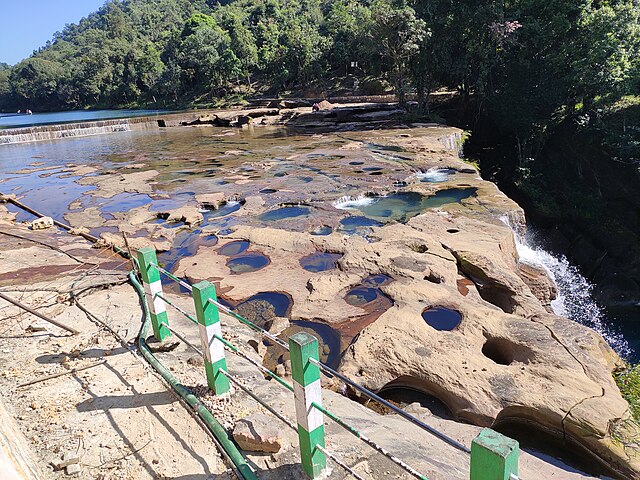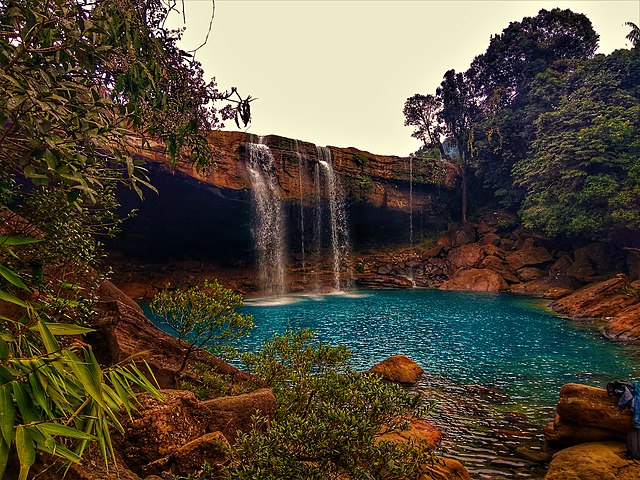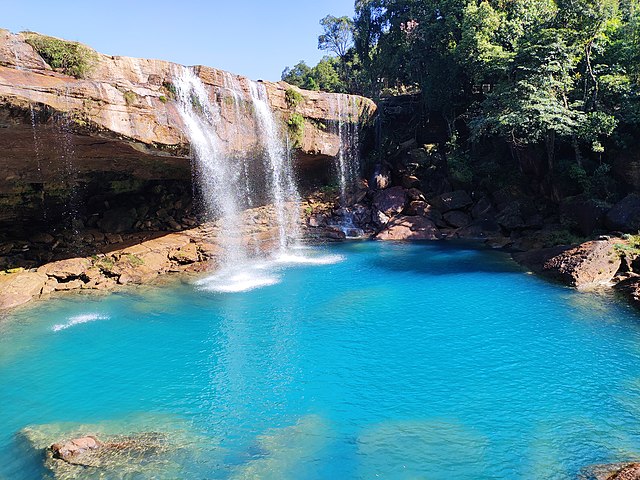Have you ever dreamed of discovering a secret paradise where crystal-clear turquoise waters cascade into natural swimming pools? Welcome to Krang Suri Falls, one of Meghalaya’s most breathtaking hidden gems that’s quickly becoming every traveler’s favorite escape.
What Makes Krang Suri Falls Special?
Nestled in the heart of Meghalaya’s Jaintia Hills, Krang Suri Falls isn’t just another waterfall – it’s nature’s own infinity pool with a twist of adventure. What sets this stunning cascade apart from countless other waterfalls across India? The answer lies in its mesmerizing turquoise waters and the unique swimming experience it offers.
The Stunning Turquoise Waters
The first thing that’ll stop you in your tracks at Krang Suri Falls is the incredible color of the water. Unlike the typical white foam of most waterfalls, Krang Suri boasts an otherworldly turquoise hue that seems almost too beautiful to be real. This striking color comes from the unique mineral composition of the rocks and the way sunlight filters through the water, creating a natural phenomenon that photographers and nature lovers can’t get enough of.
The water maintains this gorgeous color throughout the year, though it’s most vibrant during the drier months when the water is clearer and the sunlight can penetrate deeper. It’s like someone dropped a giant sapphire into the middle of the forest – absolutely magical!
Perfect Swimming and Cliff Jumping Spot
What truly makes Krang Suri Falls a standout destination is its natural swimming pool. The waterfall creates a deep, refreshing pool at its base that’s perfect for swimming, making it one of the few waterfalls in India where you can actually take a dip safely. The water is surprisingly deep – deep enough for cliff jumping from the surrounding rocks if you’re feeling adventurous.
Many visitors describe swimming in Krang Suri Falls as a surreal experience. Imagine floating in crystal-clear turquoise water while surrounded by lush green forest – it’s like being in your own private tropical paradise. The water temperature is refreshingly cool year-round, providing the perfect respite from Meghalaya’s humid climate.
Location and How to Reach Krang Suri Falls

Planning your journey to this hidden paradise requires some preparation, but trust me, every step of the adventure is worth it. Krang Suri Falls is located in the Jaintia Hills district of Meghalaya, specifically near the village of Amlarem.
Getting to Amlarem Village
Your journey to Krang Suri Falls begins with reaching Amlarem village, which serves as the starting point for the trek to the falls. From Shillong, the capital of Meghalaya, Amlarem is approximately 78 kilometers away – roughly a 2.5 to 3-hour drive depending on road conditions.
If you’re coming from Guwahati, you’ll need to first reach Shillong and then continue to Amlarem. The road to Amlarem is generally in good condition, though some stretches can be winding and require careful driving, especially during monsoons.
The Trek to the Falls
Once you reach Amlarem, the real adventure begins. The trek to Krang Suri Falls is approximately 1.5 kilometers and takes about 30-45 minutes, depending on your fitness level and how often you stop to admire the scenery (and trust me, you’ll want to stop frequently).
The trail is moderately challenging with some steep sections and rocky terrain, but it’s well-marked and manageable for most people with average fitness levels. The path winds through beautiful forest terrain, offering glimpses of the surrounding hills and valleys. During the trek, you’ll cross small streams and navigate through dense vegetation, making the journey feel like a proper adventure.
Transportation Options
For transportation, you have several options. Renting a private car or hiring a taxi from Shillong is the most convenient option, especially if you’re traveling in a group. Many local tour operators also offer day trips to Krang Suri Falls. If you’re on a budget, you can take a shared taxi or bus to Amlarem, though this might require more planning and potentially multiple transfers.
Best Time to Visit Krang Suri Falls
Timing your visit to Krang Suri Falls can make the difference between a good experience and an absolutely unforgettable one. While the falls are accessible year-round, certain months offer better conditions for swimming, photography, and overall enjoyment.
Monsoon Season Considerations
During the monsoon months (June to September), Krang Suri Falls transforms into a powerful cascade with significantly increased water flow. While this creates a dramatic spectacle, it also makes swimming dangerous or impossible due to strong currents. The trek can also become slippery and challenging during heavy rains.
However, if you’re not planning to swim and want to witness the falls at their most powerful, the post-monsoon period (September to October) can be spectacular. The water flow is still strong, the surrounding vegetation is lush and green, and the weather is generally more pleasant.
Winter Months: The Ideal Time
The best time to visit Krang Suri Falls is during the winter months, from November to February. During this period, the water flow is moderate, making it perfect for swimming and cliff jumping. The weather is pleasant with clear skies, which means better photography conditions and more comfortable trekking.
The turquoise color of the water is most vibrant during these months because the reduced water flow allows for better clarity. Plus, the cooler weather makes the trek more enjoyable, and you’ll appreciate the refreshing dip in the natural pool even more.
What to Expect at Krang Suri Falls
Arriving at Krang Suri Falls after the trek feels like discovering a secret world. The sight of the turquoise waterfall cascading into the natural pool below is breathtaking, but what should you actually expect when you get there?
The Natural Pool Experience
The natural pool at the base of Krang Suri Falls is the main attraction. It’s surprisingly deep – estimates suggest it’s around 10-15 feet deep in the center, making it perfect for swimming and even some careful diving. The pool is naturally formed and maintains its depth throughout the year, though water levels can vary seasonally.
The rocks surrounding the pool provide natural seating areas and jumping platforms for those brave enough to try cliff jumping. The highest jumping points are about 15-20 feet above the water, but there are lower options for beginners or those who prefer a gentler entry.
Adventure Activities Available
Beyond swimming, Krang Suri Falls offers several adventure activities. Cliff jumping is the most popular, with various heights to choose from based on your comfort level. The deeper sections of the pool make it relatively safe for jumping, though proper caution should always be exercised.
Photography is another major activity – the unique turquoise color and scenic surroundings make for incredible shots. Many visitors also enjoy simply relaxing by the pool, sunbathing on the rocks, or having a picnic in the natural amphitheater created by the surrounding cliffs.
Safety Precautions for Swimming
While swimming at Krang Suri Falls is generally safe, it’s important to take proper precautions. Always check the water conditions before entering – avoid swimming during or immediately after heavy rains when currents might be stronger. If you’re not a confident swimmer, stay in the shallower areas near the edges of the pool.
For cliff jumping, start with lower heights and always check the water depth and clarity before jumping. It’s advisable to jump feet-first initially to gauge the depth. Never jump alone – always have someone watching and ready to help if needed.
Photography Tips for Krang Suri Falls

Krang Suri Falls is a photographer’s dream, but capturing its beauty requires some technique and planning. The unique turquoise water and dramatic landscape offer endless opportunities for stunning shots.
Best Angles and Lighting
The best lighting for photography at Krang Suri Falls is during the late morning to early afternoon when the sun is overhead and can penetrate the forest canopy. This lighting brings out the vibrant turquoise color of the water most effectively.
For the best angles, try shooting from the rocks above the pool to capture the full cascade and the swimming area below. Wide-angle shots work well to capture the entire scene, while close-up shots of the falling water can highlight the unique color and texture. Don’t forget to include people in some shots for scale – the falls are quite impressive, and having human figures helps convey their magnitude.
Nearby Attractions and Day Trip Ideas
While Krang Suri Falls is definitely worth a dedicated trip, combining it with other nearby attractions can make for an incredible day or even a multi-day adventure in the Jaintia Hills region.
Other Falls in Jaintia Hills
The Jaintia Hills are home to several other spectacular waterfalls that can be combined with your Krang Suri Falls visit. Tyrshi Falls is another beautiful cascade located relatively nearby, offering a different but equally stunning experience. The area is also known for its limestone caves and unique geological formations.
Dawki, famous for its crystal-clear river and the cleanest village in Asia (Mawlynnong), is also within driving distance and makes for an excellent addition to your itinerary. The combination of waterfalls, caves, and unique villages provides a comprehensive taste of Meghalaya’s natural and cultural diversity.
Accommodation and Facilities
One of the challenges of visiting Krang Suri Falls is the limited accommodation options in the immediate vicinity. However, with proper planning, you can find comfortable places to stay that allow you to enjoy the falls without feeling rushed.
Where to Stay Near Krang Suri Falls
The closest accommodation options are in Jowai, which is about an hour’s drive from Amlarem. Jowai offers several hotels and guesthouses ranging from budget to mid-range options. While not luxury accommodations, they provide clean, comfortable rooms and basic amenities.
For a more unique experience, some local families in Amlarem village offer homestay options. This not only provides accommodation but also gives you insight into local Khasi culture and traditions. Homestays typically include home-cooked meals and the opportunity to interact with local families.
If you prefer more comfort and are willing to travel further, Shillong offers the widest range of accommodation options, from budget hostels to luxury hotels. However, staying in Shillong means a longer journey to the falls each day.
Essential Tips for Your Visit
A successful trip to Krang Suri Falls requires some preparation and planning. Here are the essential tips that’ll help ensure your adventure goes smoothly.
What to Pack
Packing smart is crucial for your Krang Suri Falls adventure. Essential items include sturdy trekking shoes with good grip (the trail can be slippery), swimwear, a waterproof bag for your electronics, and a first aid kit. Don’t forget sunscreen, insect repellent, and a hat for sun protection.
Quick-dry clothing is ideal since you’ll likely get wet, and bringing an extra set of clothes is always wise. A waterproof phone case is essential if you want to take photos while swimming, and a dry bag will keep your other essentials safe.
Food and Water Arrangements
There are limited facilities at Krang Suri Falls itself, so bringing your own food and water is essential. Pack energy bars, fruits, and other non-perishable snacks for the trek and your time at the falls. Bring more water than you think you’ll need – the trek and swimming can be dehydrating.
Some visitors prefer to arrange packed lunches from their accommodation, which can be a great way to enjoy a meal in the beautiful natural setting. Just remember to carry out all your trash – leaving no trace is crucial for preserving this pristine environment.
Local Culture and Community
Visiting Krang Suri Falls also offers an opportunity to experience the rich culture of the Khasi people who call this region home. The local community plays a vital role in maintaining and protecting these natural treasures.
The Khasi people have a matrilineal society and deep respect for nature, which is evident in how well-preserved areas like Krang Suri Falls remain. Many locals work as guides and are incredibly knowledgeable about the area’s history, flora, and fauna. Engaging with local guides not only enhances your experience but also supports the local economy.
The villages around Krang Suri Falls maintain traditional ways of life, and visitors often find the simplicity and warmth of the local people refreshing. Learning about their customs, trying local food, and understanding their relationship with the natural environment adds depth to your visit.
Environmental Conservation
As Krang Suri Falls gains popularity, environmental conservation becomes increasingly important. The pristine nature of this location depends on responsible tourism practices from all visitors.
The “Leave No Trace” principle is crucial here. This means carrying out all your trash, not disturbing the natural environment, and avoiding the use of soaps or chemicals in the water. The turquoise color and clarity of the water are natural phenomena that can be easily disrupted by pollution.
Local communities and environmental groups are working to balance tourism development with conservation efforts. As a visitor, you can contribute by choosing eco-friendly options, respecting local guidelines, and spreading awareness about responsible tourism practices.
Planning Your Krang Suri Falls Adventure
Ready to experience the magic of Krang Suri Falls for yourself? Planning your visit properly will ensure you make the most of this incredible destination while staying safe and respecting the local environment.
Start by checking weather conditions and planning your visit during the optimal months (November to February for swimming, September to October for dramatic water flow). Book your accommodation in advance, especially during peak tourist season, and arrange reliable transportation.
Consider your fitness level when planning the trek, and don’t hesitate to take breaks and enjoy the journey. The trek to Krang Suri Falls is part of the adventure, not just a means to an end. Pack appropriately, respect the local environment and culture, and prepare for an unforgettable experience in one of India’s most beautiful hidden gems.
Remember, places like Krang Suri Falls are precious precisely because they remain relatively untouched. By visiting responsibly and sharing your experience thoughtfully, you help ensure that future generations can also enjoy this natural paradise.
Conclusion
Krang Suri Falls represents everything that makes Meghalaya special – pristine natural beauty, adventure opportunities, and a sense of discovery that’s becoming increasingly rare in our connected world. This turquoise paradise offers more than just a pretty view; it provides an experience that connects you with nature in its purest form.
Whether you’re seeking adventure through cliff jumping and swimming, looking for that perfect Instagram shot, or simply wanting to escape the chaos of everyday life, Krang Suri Falls delivers on all fronts. The journey to reach it becomes part of the reward, and the memories you create there will last a lifetime.
As this hidden gem gains recognition, the key is visiting responsibly and respecting both the natural environment and local community that make such places possible. Plan your trip thoughtfully, pack appropriately, and prepare for an adventure that will remind you why some of the world’s most beautiful places are worth the extra effort to reach.
Frequently Asked Questions
1. Is it safe to swim in Krang Suri Falls?
Yes, swimming in Krang Suri Falls is generally safe during the dry season (November to February) when water levels are moderate. The natural pool is deep enough for swimming and cliff jumping, but always check current conditions, avoid swimming during monsoons, and never swim alone. Start with shallow areas if you’re not a confident swimmer.
2. How difficult is the trek to Krang Suri Falls?
The trek is moderately challenging, covering about 1.5 kilometers with some steep and rocky sections. It typically takes 30-45 minutes and is manageable for people with average fitness levels. Proper trekking shoes are essential, and the trail can be slippery during monsoons, so extra caution is needed during rainy periods.
3. What makes the water at Krang Suri Falls turquoise in color?
The stunning turquoise color comes from the unique mineral composition of the limestone rocks and the way sunlight filters through the water. This natural phenomenon is most vibrant during clearer weather and when water levels are moderate, typically during the winter months.
4. Can I visit Krang Suri Falls during monsoon season?
While you can visit during monsoons (June-September), swimming is not recommended due to strong currents and high water levels. The trek also becomes more challenging and slippery. If you visit during this time, it’s mainly for viewing the dramatic increased water flow rather than swimming.
5. Are there accommodation options near Krang Suri Falls?
Direct accommodation at the falls is not available, but you can stay in Jowai (about 1 hour away) which offers hotels and guesthouses, or choose homestays in nearby Amlarem village for a more authentic experience. Shillong, while further away, provides the most accommodation options but requires a longer daily journey to the falls.

